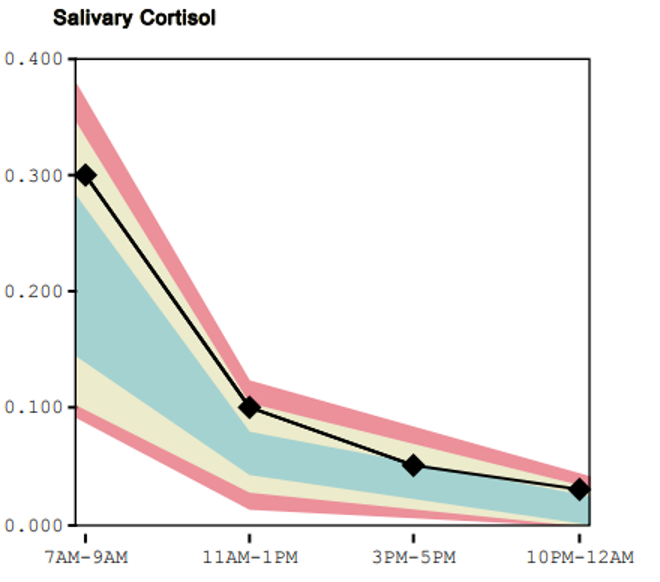We use cookies to enhance your browsing experience and analyze the performance of our website. By clicking Continue, you agree to the use of cookies. For more information, please see our Privacy Policy or update your Cookie Preferences.


Your adrenal glands help you respond to stress by producing hormones like cortisol and DHEA. Assessing these hormones with a simple saliva collection through the Adrenocortex Stress Profile gives insight into how well your body handles stress. If you're feeling tired, gaining weight, having trouble sleeping, or struggling with focus or mood, these results might help explain why.
Cortisol is your body's main stress hormone. It should be high in the morning (to help you wake up) and gradually drop throughout the day. Your report includes a line graph showing how your levels compare to this ideal pattern. The green zone is the healthy target range. Yellow means borderline, and red (or outside of the shaded areas) is out of range.1

If you see spikes above the green zone, your body is likely reacting to stress. That stress might be emotional (arguments, work pressure), physical (pain, intense exercise), or lifestyle-related (poor sleep, too much caffeine, skipping meals). High cortisol over time can lead to sleep issues, anxiety, weight gain, high blood pressure, and more.123
Low cortisol can be a sign that your body has been under stress for too long and is starting to wear down. You might feel exhausted, moody, dizzy, or have more aches and pains. This means your stress response isn't bouncing back the way it should.23
DHEA is another hormone made by your adrenals. It's known for being restorative and protective - helping with brain function, energy, and the production of hormones like estrogen and testosterone.4 Just like cortisol, DHEA has an optimal range (green), a borderline zone (yellow), and out-of-range (red).

This ratio compares how much DHEA (restorative) you have relative to cortisol (stress). A higher ratio means your body is in a better state of repair and balance. A lower ratio means stress is winning out and may be wearing your system down.

Below the graph is a chart showing your actual hormone levels at each saliva collection time. Compare the time you collected the sample (bottom row) to the ideal windows (top row). If you were off schedule, your results might still be helpful, but keep that in mind when interpreting the graph. In general, as the day progresses, you want to see cortisol decreasing.

The good news: you can often improve adrenal health naturally. Start by identifying stress triggers (emotional, physical, or lifestyle) and find ways to reduce or manage them. Mindfulness, sleep support, steady blood sugar, and gentle exercise all help. For tips, check out this article on stress and weight.
For more personalized guidance, consider working with a healthcare provider who understands adrenal health and functional medicine.
Keep learning! Listen to our podcast, The Lab Report: 'Patti & Michael Discuss HPA Axis Dysfunction'
This article is for informational purposes only and is not a substitute for medical advice or treatment.